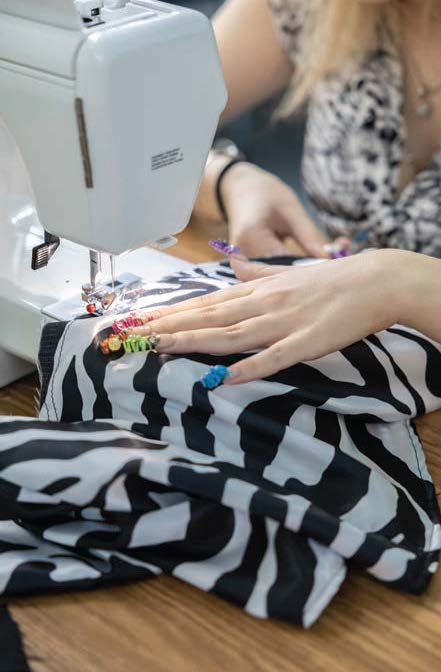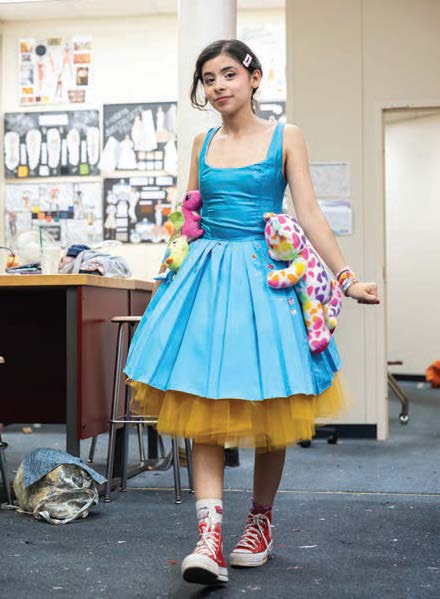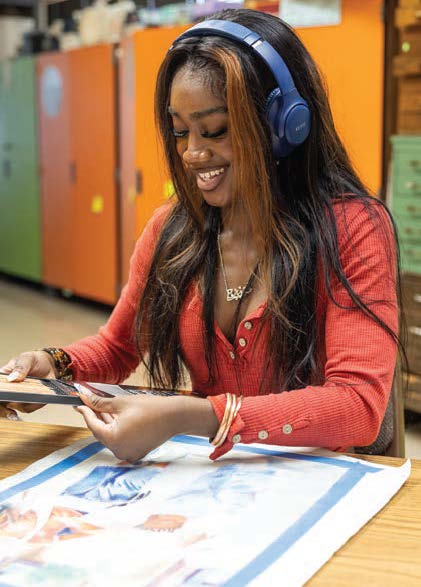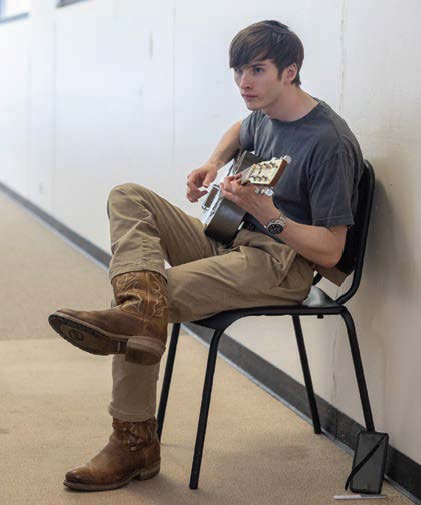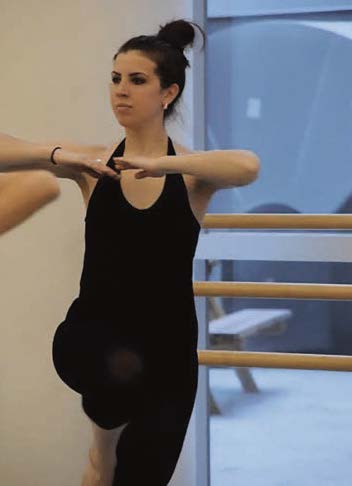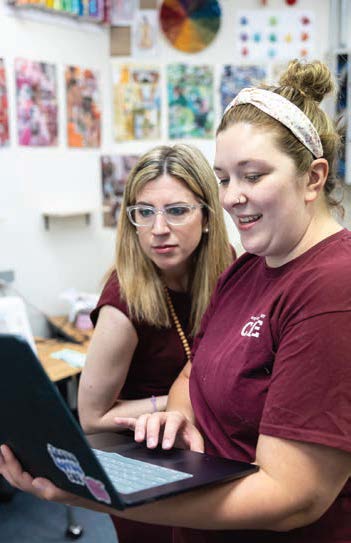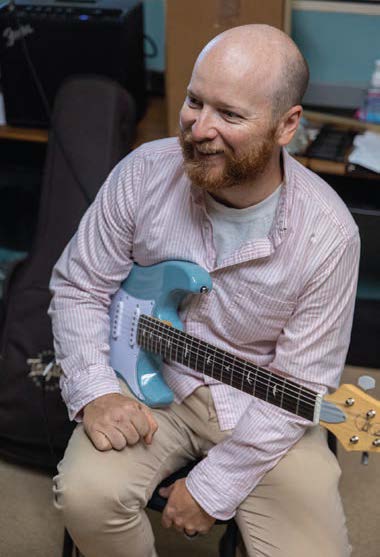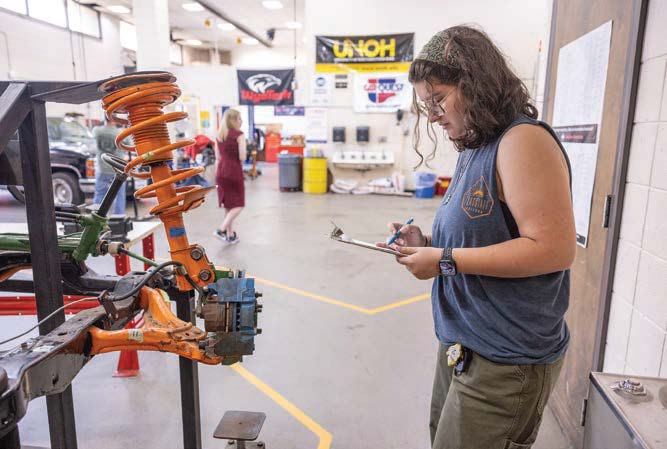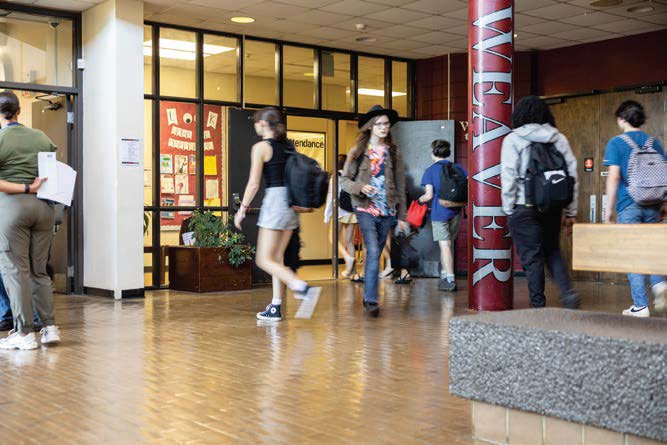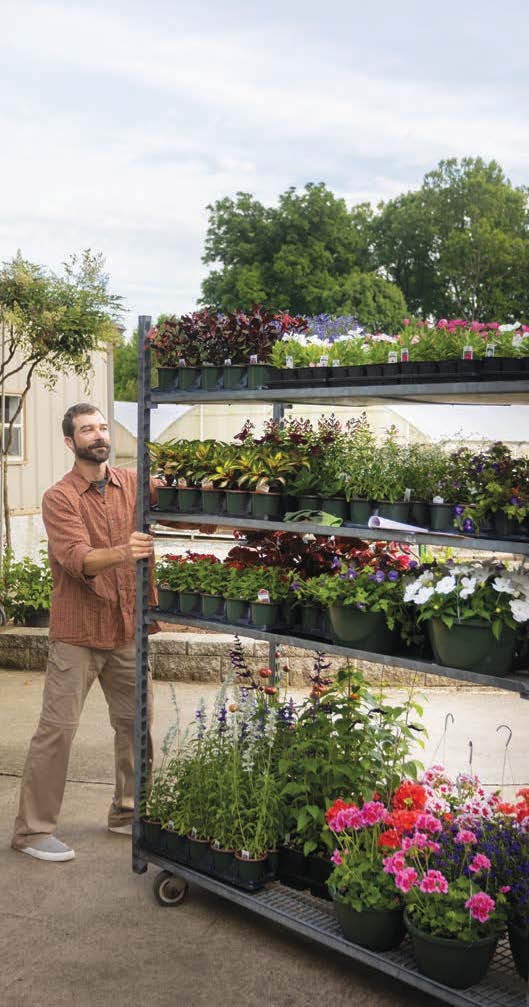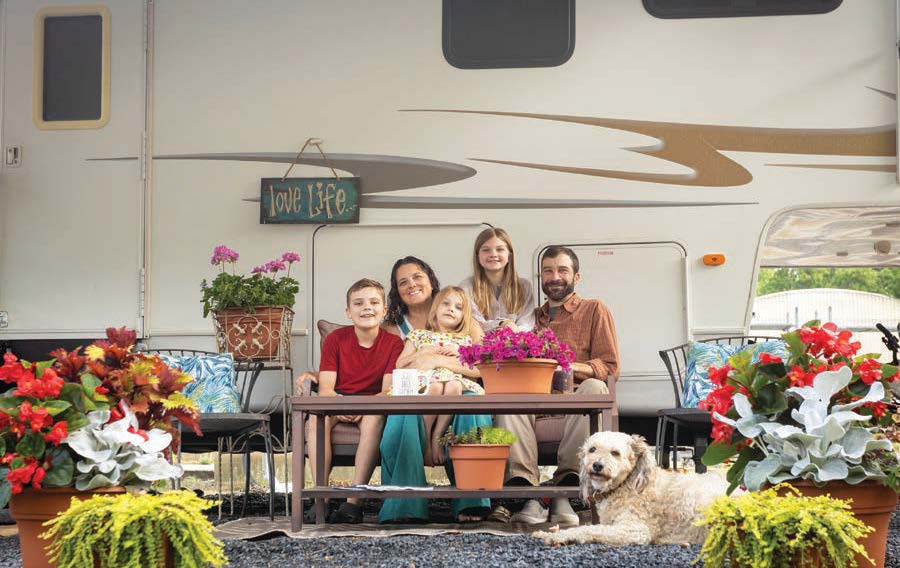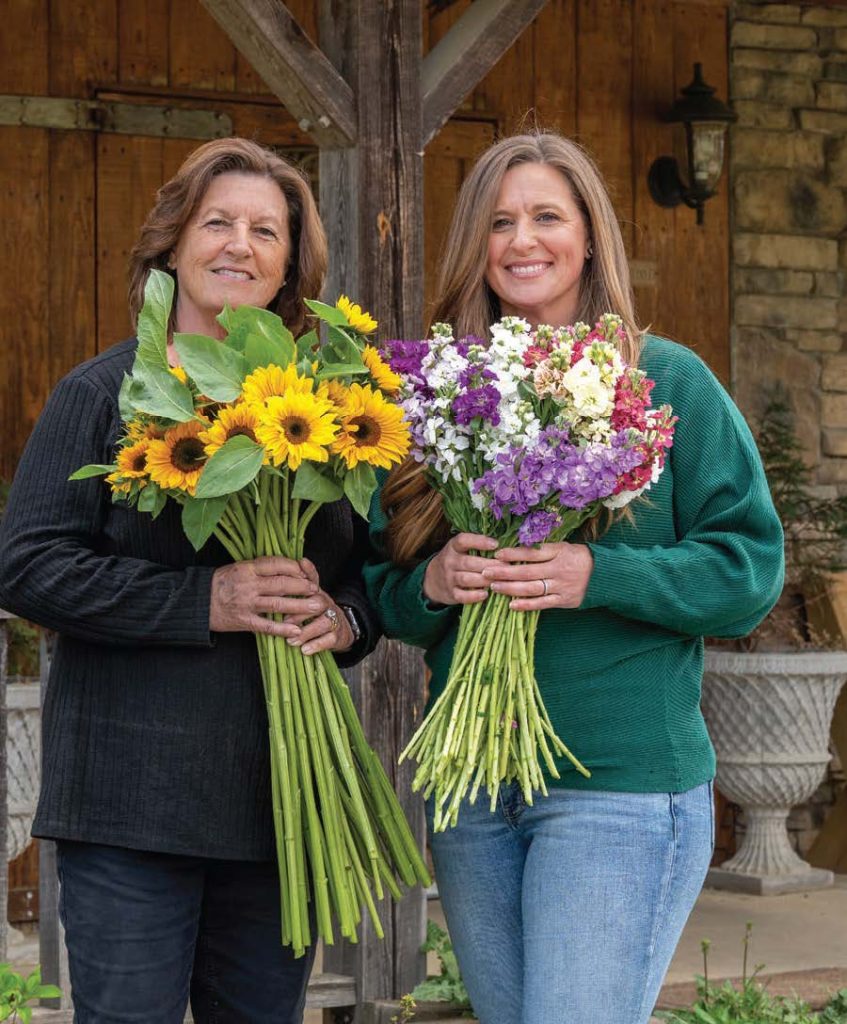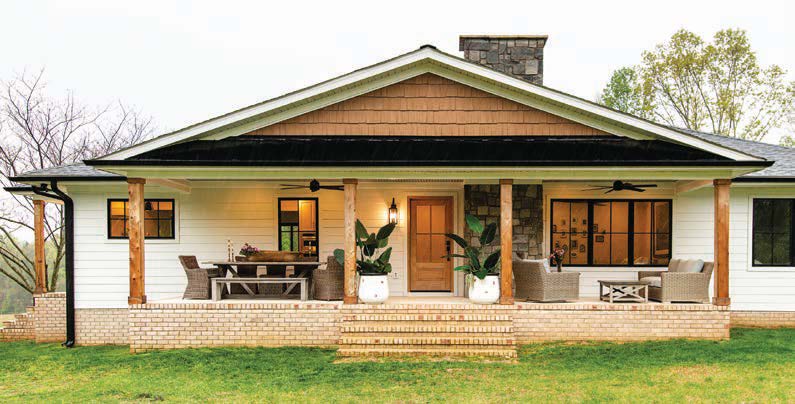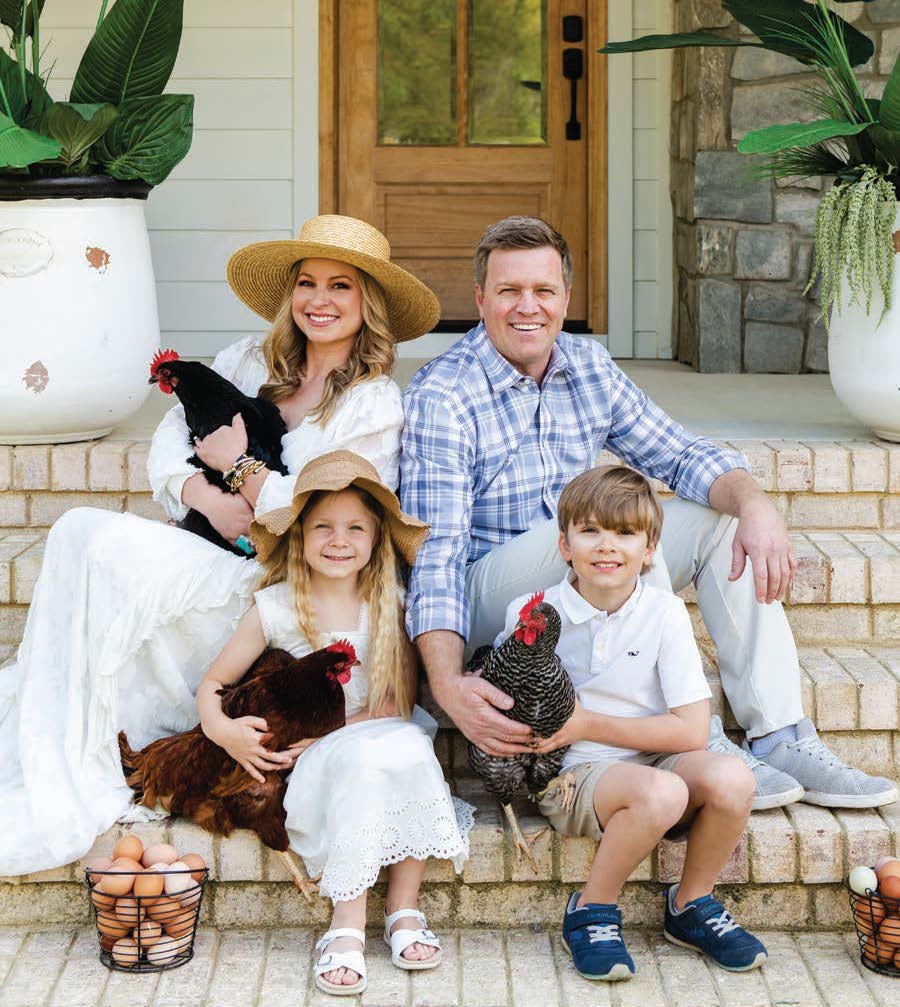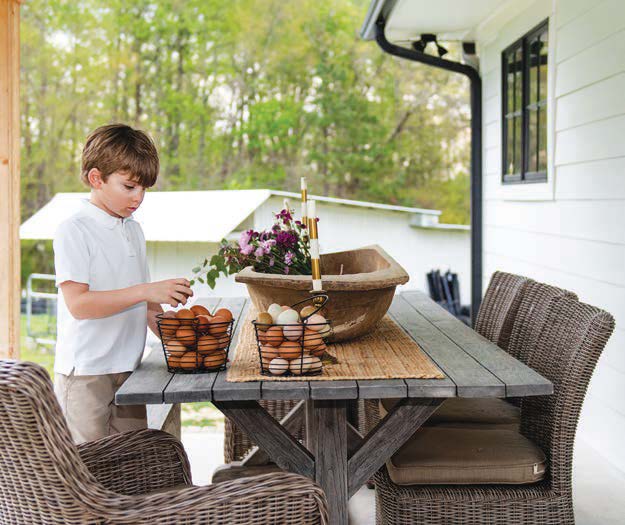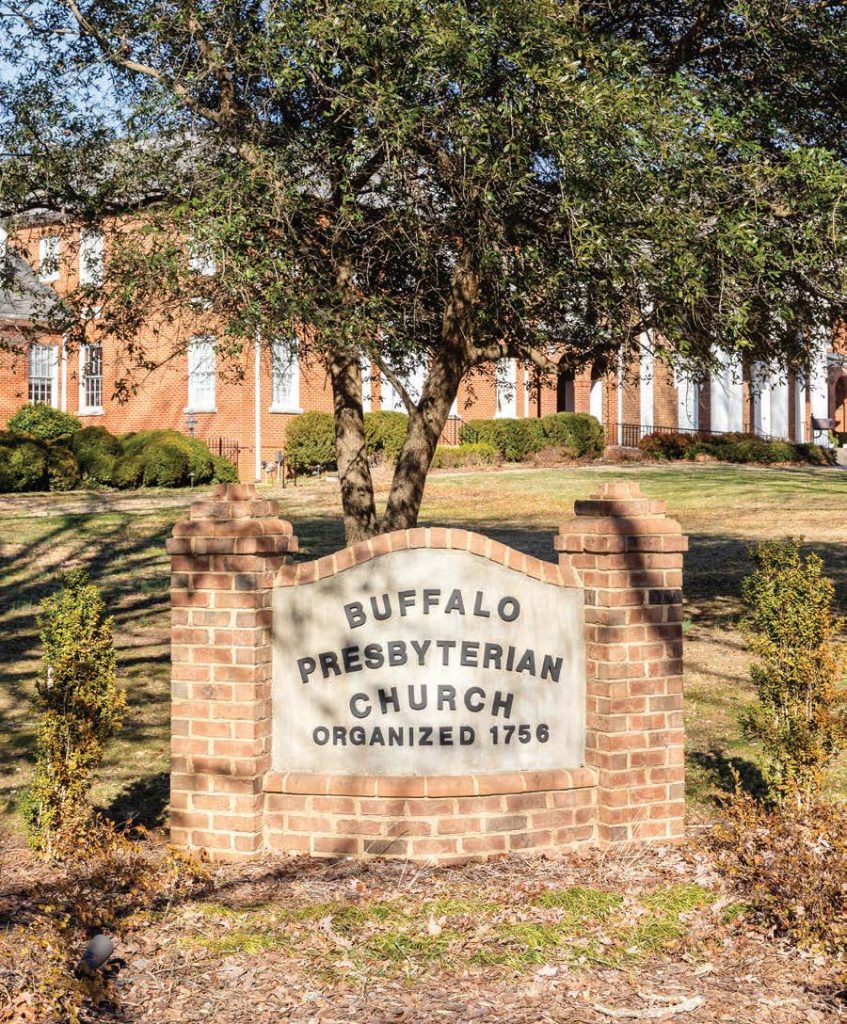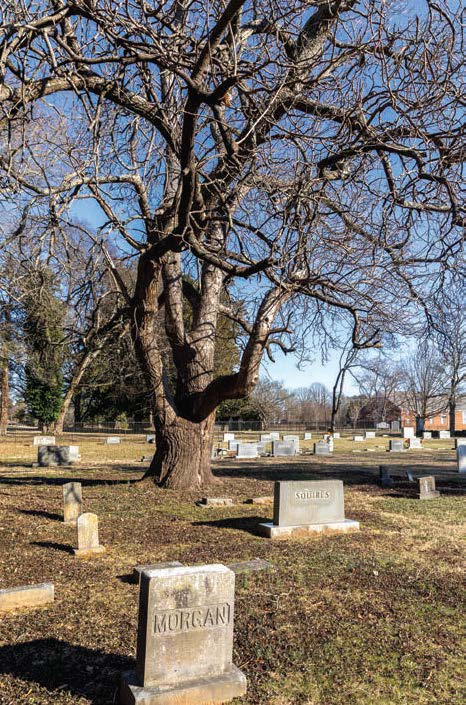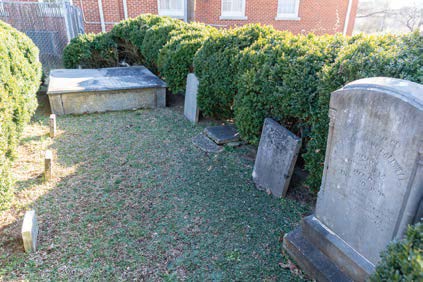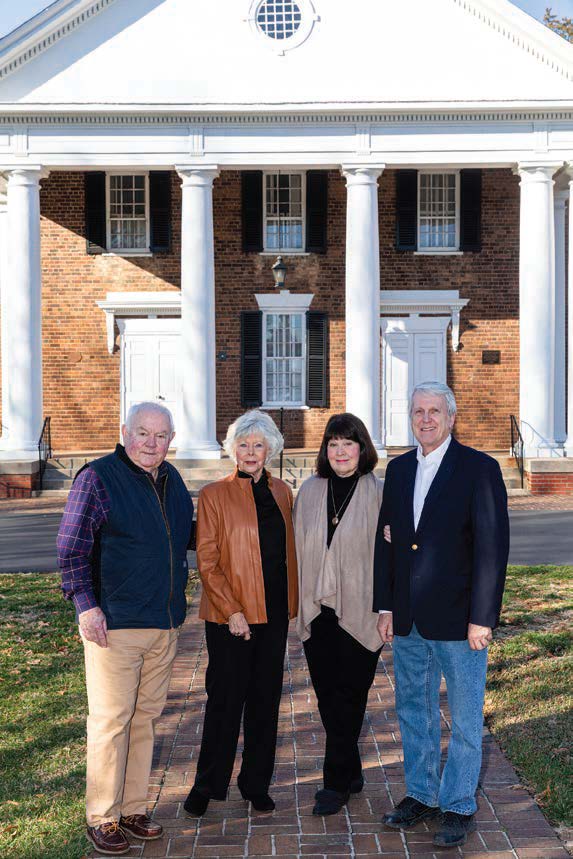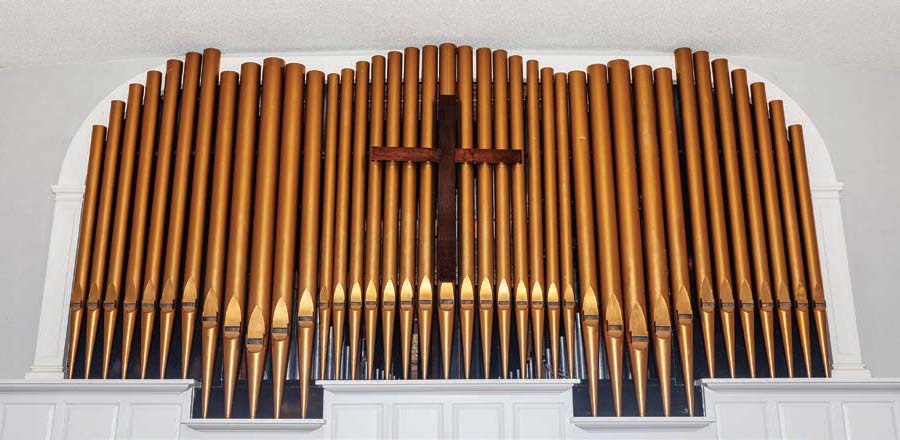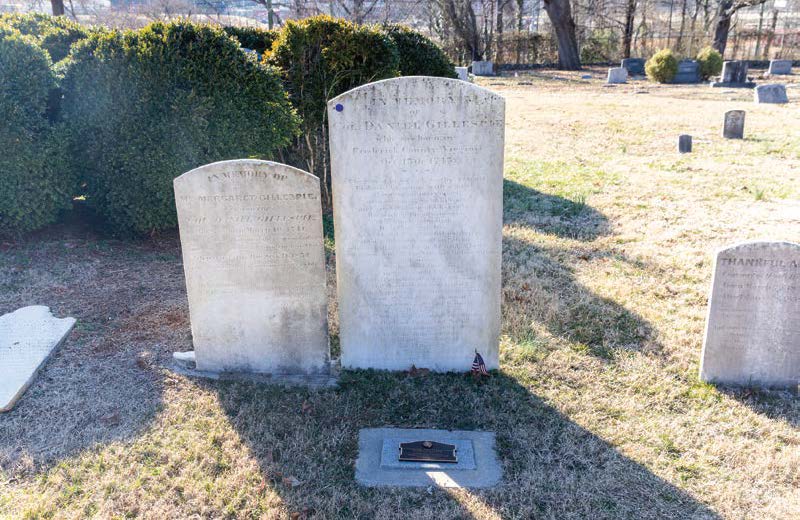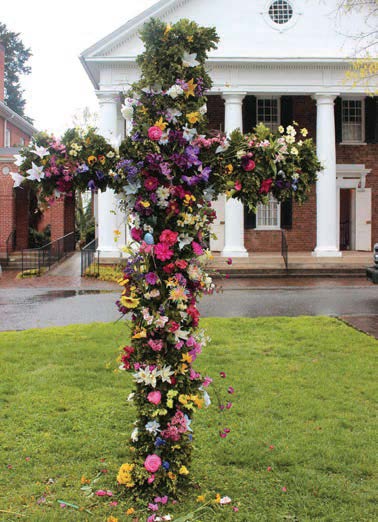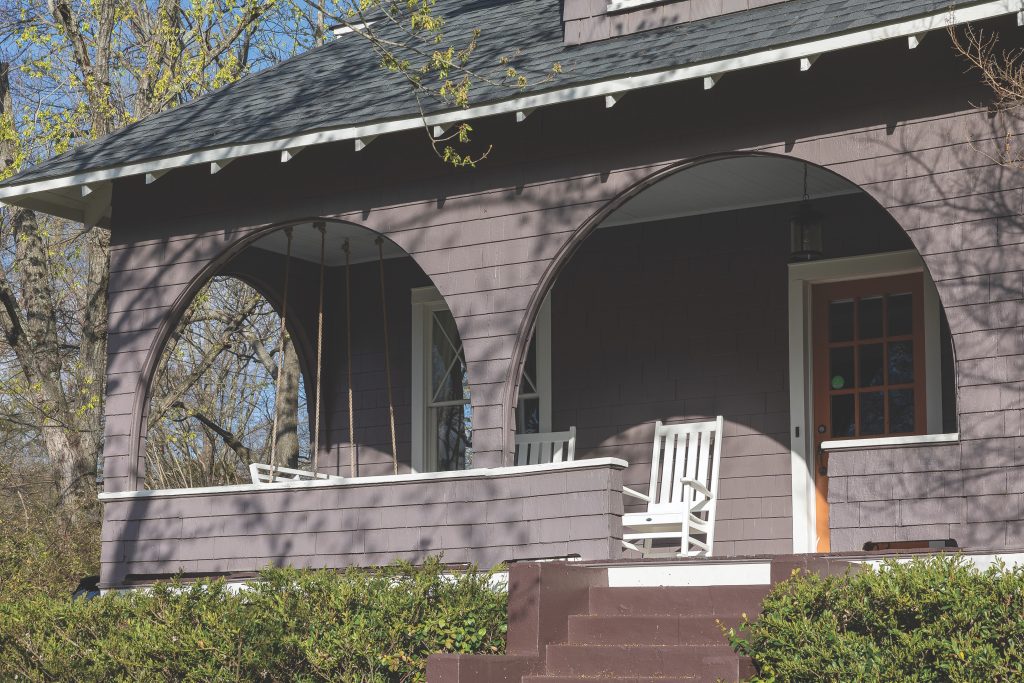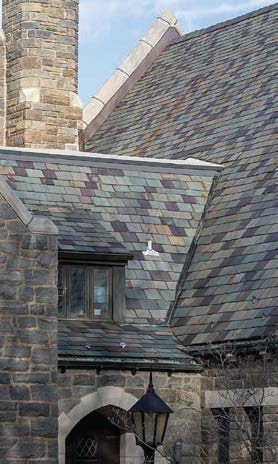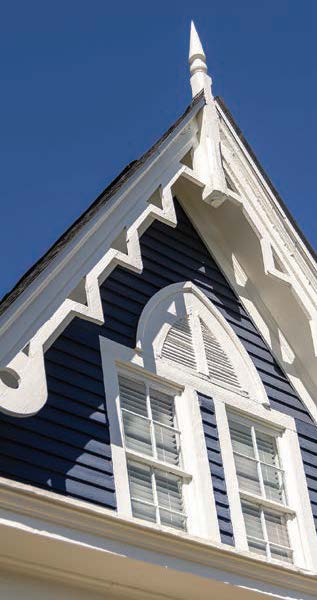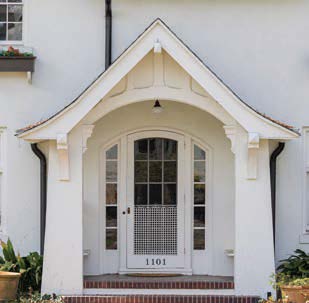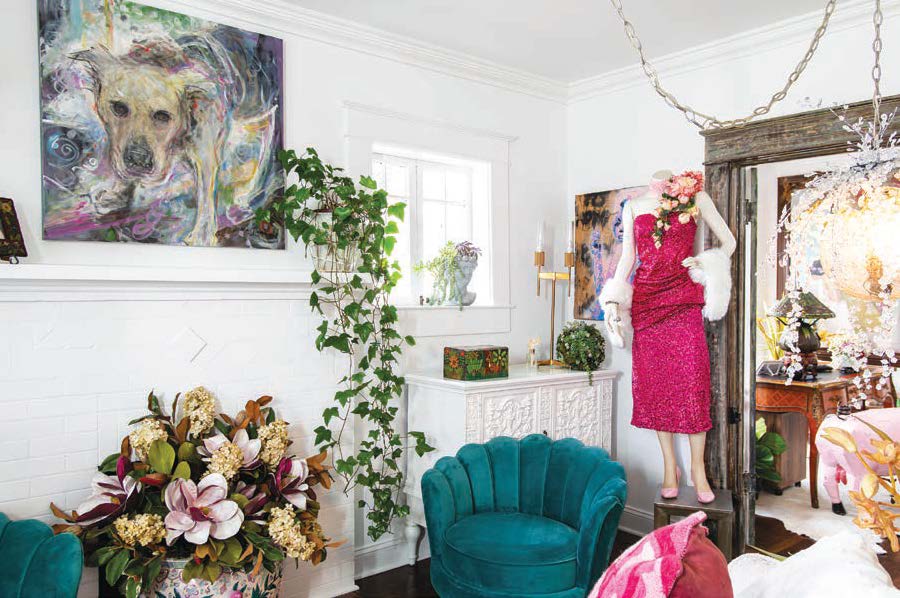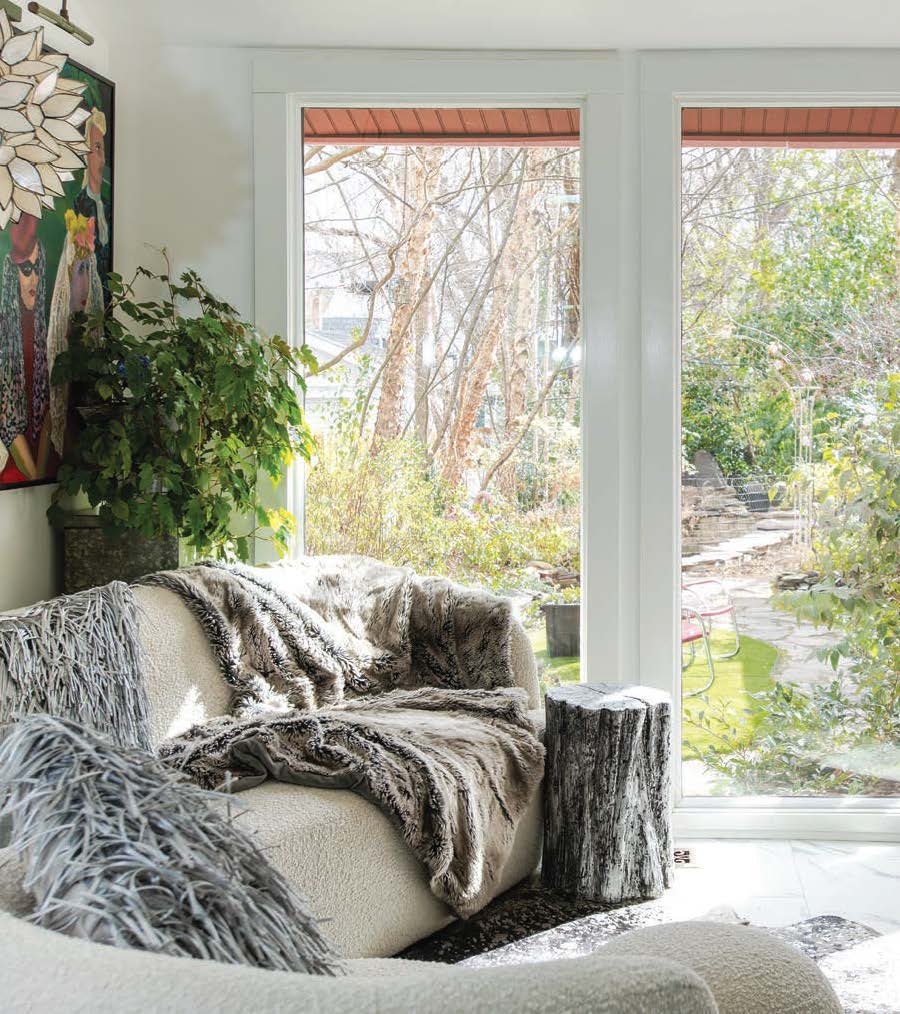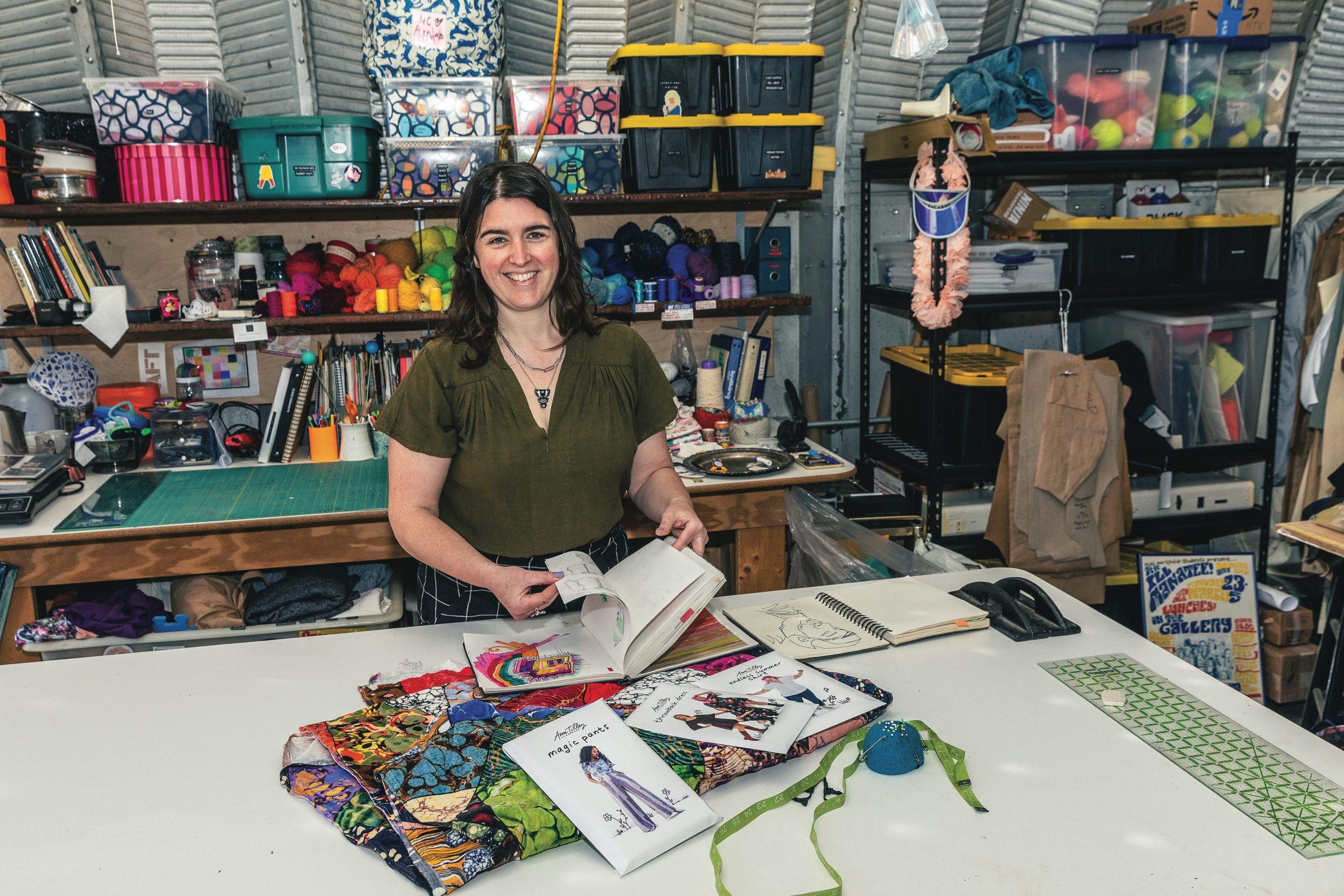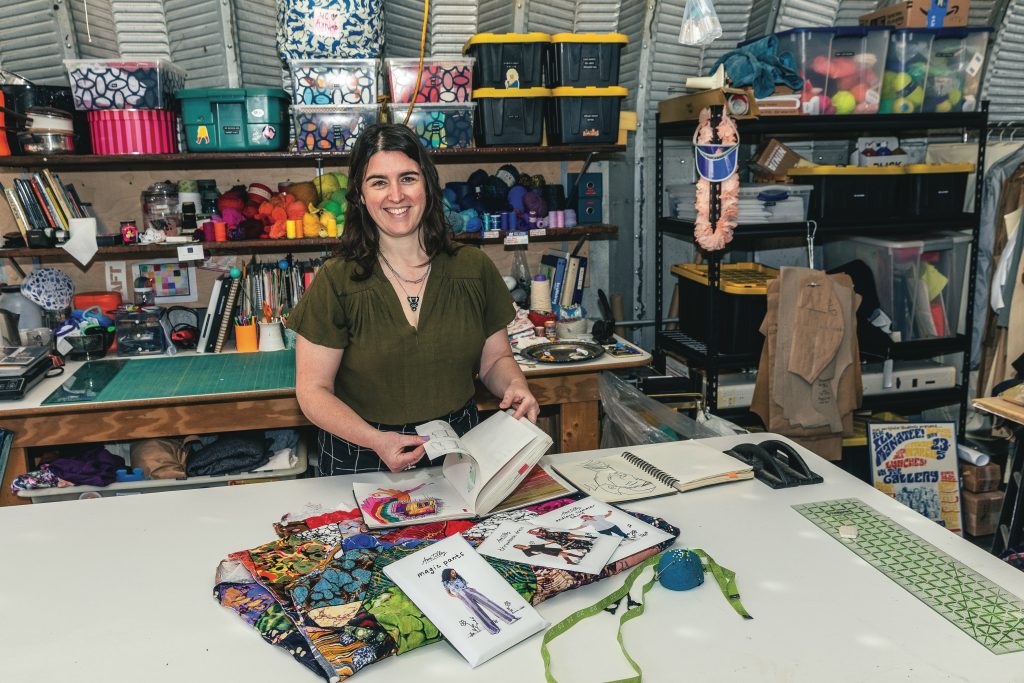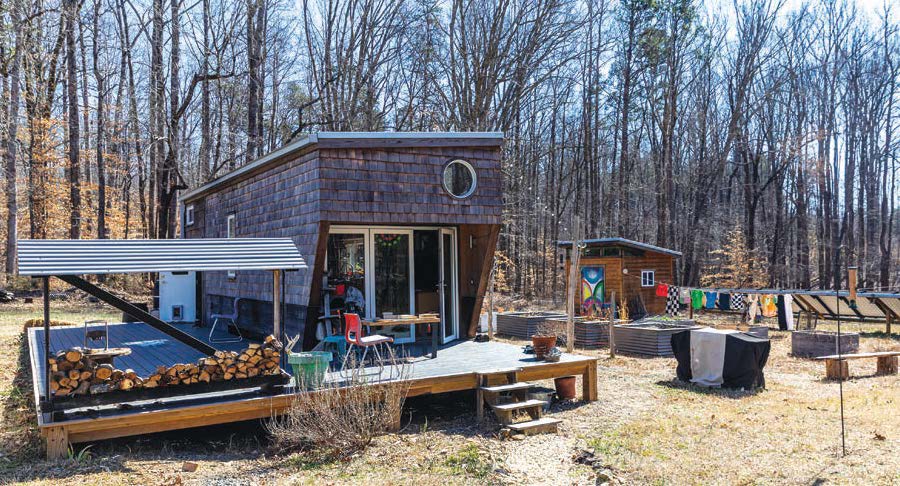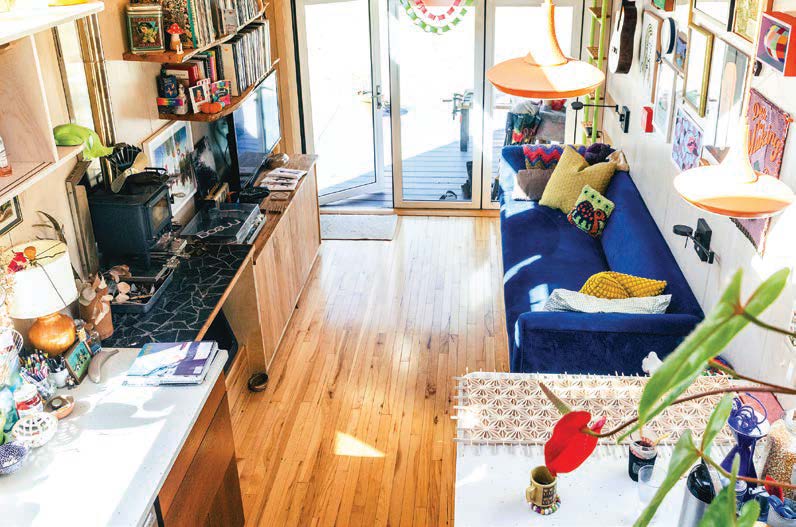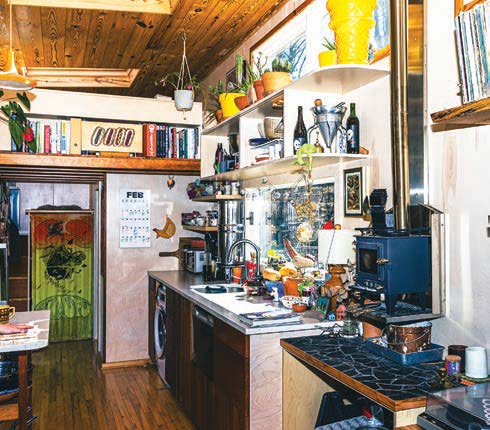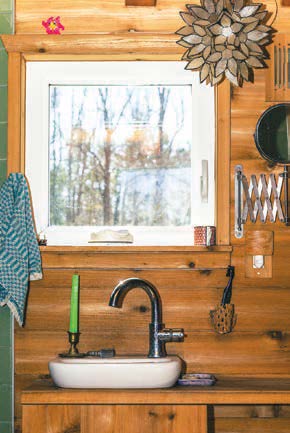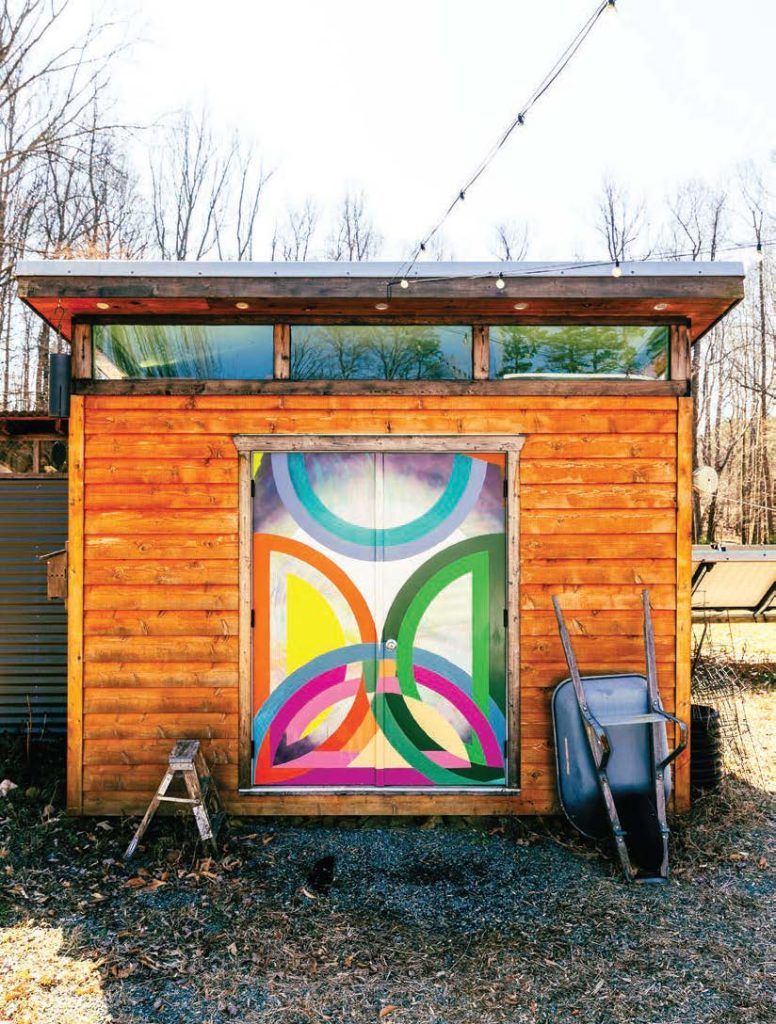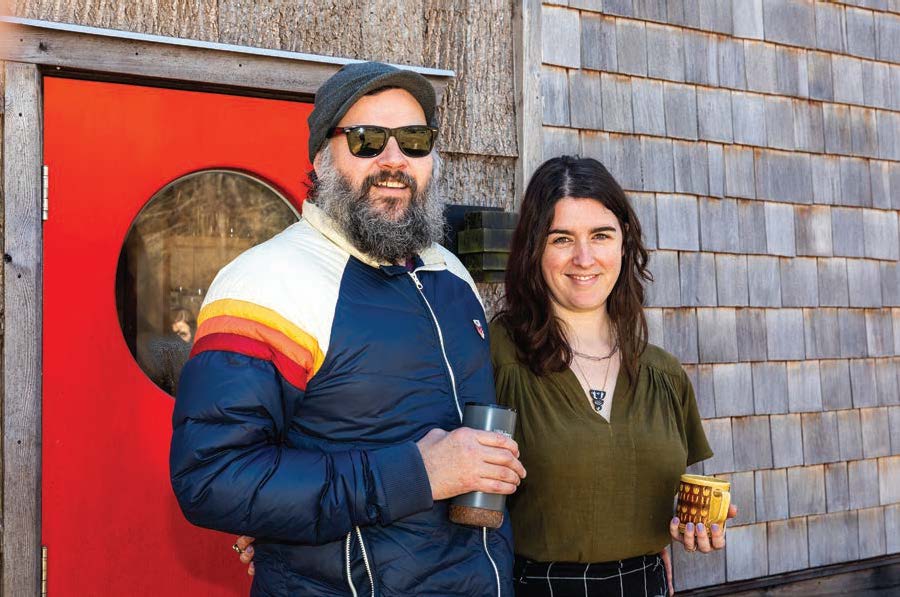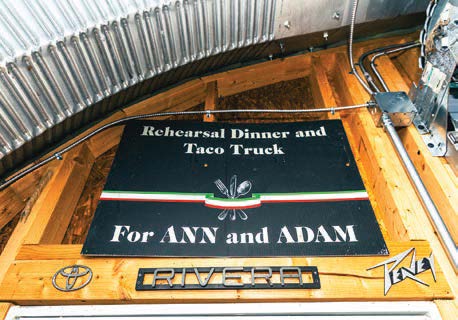Among the Wildflowers
AMONG THE WILDFLOWERS
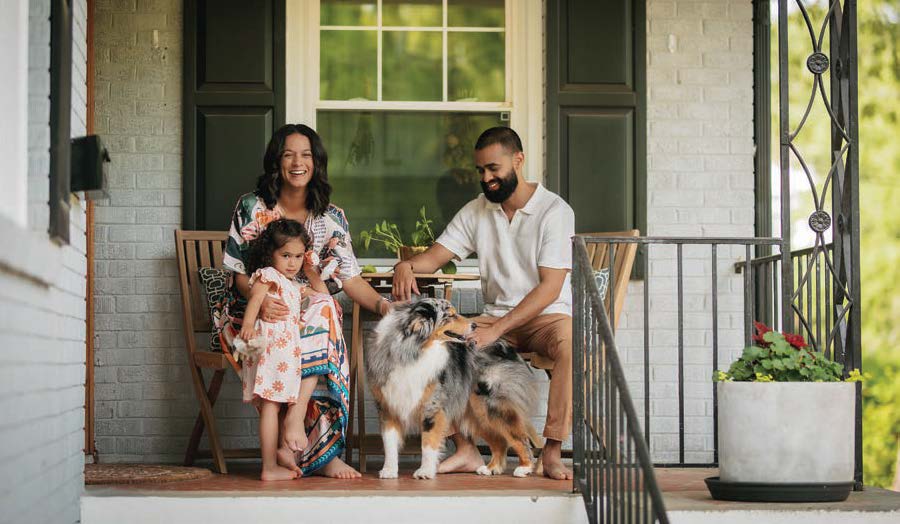
Among the Wildflowers
A 1950s Sunset Hills charmer blooms anew
By Cassie Bustamante • Photographs by Betsy Blake
Making your way toward downtown Greensboro along Friendly Avenue, a burst of fiery red and vibrant purple might catch your eye as you pass through Sunset Hills. Wildflowers — poppies and Larkspur, to be exact — bloom along the fence line of a 1950s rancher. The seeds were sown just last year, although this particular house has been a colorful source of comment for years. In fact, if you drove by five years ago, its teal-and-purple exterior would have surely grabbed your attention.
Formerly, the single-family house was a duplex, says Rachel Azam, who currently shares the home with her husband, Najib, their 3-year-old daughter, Zaara, and her 18-year-old stepson, Khalil, who attends the North Carolina School of Science and Mathematics and will head to UNC-Chapel Hill in the fall. And let’s not forget Sophie, the family’s blue-eyed Aussie, a glutton for belly rubs. Originally from Pleasant Garden, Rachel recalls often cutting through Sunset Hills when she was a child. “I grew up watching this house change color,” she muses.
In August 2020 at the height of the pandemic, the once likely Charlotte Hornets-inspired home was sold, flipped into a fresh, gray-and-white, clean slate, and put on the market right after the New Year holiday. Almost immediately, the Azams put in an offer.

Rachel, barefoot, stands in her bright, white kitchen, wearing relaxed, barrel jeans and a cropped white T-shirt. Her chocolate-brown eyes peer out from underneath a Duke baseball cap, her thick, brown hair hitting just below her shoulders. A warm, homemade breakfast quiche, fresh from the oven, fills the home with a toasted, buttery, come-hither smell. A bowl of oranges sits on the island counter next to a vase filled with fresh flowers in oranges and pinks. “We have a dance party in here every morning per Zaara’s request,” says Rachel.
As if on cue, Zaara twirls into the room, dark curls bouncing, and shouts, “Play ‘Cruel Summer!’” Rachel notes that most mornings it’s Broadway tunes, Wicked or Taylor Swift.
“T. Swift don’t miss,” quips Najib with a glint in his own brown eyes. He’s on his way to the Research Triangle, where he works in risk control for UBS, an investment banking company, but not before giving his wife and daughter each a kiss. “Bye, Zaari!” he says as Zaara demands a second hug from Daddy.
While the couple originally met as high schoolers training to be counselors at North Carolina for Community and Justice’s Anytown camp, they didn’t really get to know each other until much later. Najib, who grew up in nearby Jamestown, attended undergrad at UNC-Charlotte and went on to earn his law degree from UNC. Rachel graduated from UNCG with a B.S. in nursing. Mutual friends brought them together eventually. Nick, Najib’s best friend from college, is the older brother of Rachel’s own childhood best friend, Sarah. But Rachel remembered Najib, who is a couple years older than her, from those teen years at camp because his name was unusual. And he’s told her, she says, “I definitely remember you, wink wink.”
In the fall of 2018, the couple first exchanged vows right here in Greensboro. “We are a multicultural household,” says Rachel. Najib is Arabic and his family hails from Bangladesh, “so we had our big Bengali ceremony and reception in October 2018.” Less than a year later, in June 2019, the couple, with photographer Ellie McKinney and their loved ones, hopped the Atlantic Ocean and held an Irish ring ceremony, honoring Rachel’s heritage, in the seaside town of Galway, Ireland.
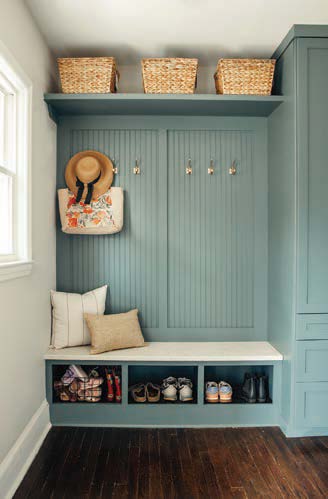
While still in their honeymoon phase in November 2019, Rachel took a new position working in pediatric endocrinology, specifically in diabetes, within the Duke University healthcare system. The work was particularly meaningful to her. At age 11 while studying dance at the UNC School of the Arts, she was diagnosed with type 1 diabetes. Although she returned home after the diagnosis, dancing has always held a special place in her heart. Granted, the job meant a big commute from their Charlotte condo, but Rachel loved the work.
Soon after starting her new position, the medical world was turned on its head when the COVID pandemic descended upon America in March 2020. Rachel began working a hybrid model, often doing telehealth appointments with patients and caregivers. Thankfully, she says, the technology has come a long way from when she was a child living with diabetes. Now, remote monitoring is available. “My senior year of high school was when I got my first insulin pump. It was life changing.”
Suddenly, in 2020, both Rachel and Najib — like most of the world — found themselves at home much more often and in need of an outlet, and, she quips, “You can only do so many at–home workouts.” Rachel, who’d arranged her own wedding flowers both stateside and in Ireland, found joy in floral design. Still in Charlotte, she’d visit her local farmstand and would come home with “buckets of blooms.” A seed was planted and, before she knew it, grew into Flower Barre, a bespoke floral design company named with a nod to what she calls her first love, dance.
To get a change of scenery, the Azams ended up taking an extended stay at Najib’s parents’ Jamestown home, often wandering through Greensboro neighborhoods as a diversion. Though they’d seen themselves as never returning to the area they grew up in, the more they walked, the more they thought, “We could live in this area.”
And when the adorable 1,600-square-foot house situated on the corner of East Greenway and Friendly popped up on Redfin, they wasted no time. That offer they submitted was readily accepted.
As it turns out, the timing was impeccable. Just a week after going under contract, the couple found out they were expecting. Naturally, the first room they tackled was Zaara’s nursery, which has since transitioned into her “big-girl” room. The walls are a soft, ballet-slipper pink, the windows are flanked by tonal pink, floor-length drapes, and the bedding features blooms in rosy pinks and golden yellows with stems of sage green, lady bugs scattered here and there. On her corner bookcase, overflowing with board books, a vase holds a bouquet of dried wildflowers, special to Rachel because they’re from the arrangements she made for Zaara’s first birthday, where the theme was “Wild One.”
While the home was a move-in ready, blank canvas, the landscaping was a clean slate — there wasn’t any. The couple poured their time and energy into their front yard. Rachel’s “jack-of-all-trades” dad, who raises beef cattle on a Pleasant Garden family farm, shared his skills and knowledge. With Najib, he carved out a pea-gravel pathway and installed French drainage.

The couple began planting beds, amping up the home’s curb appeal. Next came the backyard. “It was a bamboo forest,” Rachel quips. She has plans to keep adding here and there, year after year, starting with hydrangeas and echinacea this year.
Inside, they’ve put their personal stamp on their home bit by bit with splashes of color, mostly blue-greens. Rachel says those shades remind her of the ocean; they have a calming effect.
For the kitchen bar area, Rachel selected a blue-and-gold wallpaper featuring whimsical stems of wildflowers. She found sturdy wooden shelves on Etsy. Najib installed both the wallpaper and the shelves. But the nook’s pièce de résistance is framed artwork, swirls of red with splashes of green and purple. “That’s one of Zaara’s first little finger paintings,” says Rachel proudly.
Rachel’s most recent touch to the home interior is a bold and vibrant floral wallpaper hung by the back door. The colors mimic that of Zaara’s bedding, though more saturated and with hints of Rachel’s second-favorite color, magenta. She painted the adjacent door in a dark teal shade, though, she notes, “It’s got some scratchies because of the dog — you know!”

A drop zone already existed near the back door with hooks and cubbies for shoes, but next to it was a blank wall — wasted space in a small home. Rachel reached out to her pal, Emma Millard, who, she’d noticed, was offering design work in addition to working in real estate. The two had met at the first big wedding Rachel had done as a florist, where Emma’s best friend was the bride. Emma and Rachel, both pregnant, bonded quickly and their daughters were born just a month apart.
That once blank wall is now a functional built-in. Emma maximized the limited space, designing cabinetry custom-made by Greg Van Wyk, owner of Foxbury Woodworks in Oak Ridge. Greg installed and painted it — blue-green, naturally.
From here, Zaara can be heard singing along to Moana 2. She dances in front of the TV screen, lost in her own Hawaiian reverie for the moment, but happily takes a beat to show off her modern dollhouse in the corner of the living room, where goldenrod pillows add a warm touch.
Sophie expectantly sits nearby, whimpering for attention, her little bum wiggling in anticipation. Rachel translates: “Hi, I am here, in case you forgot about me. And this is my toy basket.”
In the entry, a painting of a woman wearing a blue-and-white striped dress holding a little girl’s hand as they walk through a field of poppies and larkspurs hangs in a gilded frame. The artist’s initials? “N.A.”
“This is Zaara and I,” says Rachel wistfully. “Najib painted this for me for my birthday.” The family had visited Dogwood Farms, a you-pick flower farm in Belews Creek, and, unbeknownst to her, Najib had snapped a photo to use as his inspiration. Rachel is in awe of how he can use both sides of his brain, though she herself toes the line between science and artistry on a regular basis, too.
As a high schooler, it turns out, Najib took lessons from local artist Anne Kiefaber. During the pandemic, she opened her home studio to budding artists as long as they wore masks. Like Rachel, Najib had needed his own outlet. “So he and Khalil started going together to art class once a week,” says Rachel. Now, almost five years later, he’s still going and currently working on a piece for friends of theirs.
A moss-covered fairy house decorated with purples and oranges sits on a table below the painting. Najib’s friend, Nick, gave Zaara the kit for Christmas. “It’s just too good to put outside,” quips Rachel, “so it’s just part of the home decor!”
“We love fairies, don’t we?” she asks her daughter.
“There are three little girls down the street who had a couple of fairy houses outside in the front yard,” she says. “We couldn’t walk past the house without stopping to play with the fairies.” The little girls took notice and began writing letters to Zaara from the perspective of River Lily, the fairy who lives there. This year, the girls have expanded into an entire fairy village that has little Zaara enchanted.
Back in their own yard, they’re working their own magic. Soon, the poppies and Larkspur along the fence — her cutting garden — will be replaced by new flowers. Last year, she planted heirloom zinnia seeds “and they actually worked!” She was able to supplement purchased stems with blooms from her garden.
Of course, there are a few blooms that hold a special place in Rachel’s heart. She loves vibrant blossoms that lend to her style, which she calls “a little wild and a little funky,” naming Dahlias — “most of them look like an amazing firework — and lisianthus. “I love the poppy,” she says. “They’re quite magical in that they come up and they are super, super tight in their pod and then they just emerge and they have these beautiful flow-y petals and really dynamic shape.”

These days, Rachel buys most of her blooms through a Winston-Salem wholesale company that supports North and South Carolina farmers. Where she expected to face competition, she has been pleasantly surprised. “We all pitch in and are helping each other,” she says. She even rents space occasionally from fellow florist Joneswell Flowers, which happens to be conveniently close to Zaara’s preschool.
And Zaara, whose name means “blossoming flower” in Arabic, loves working at the shop by her mom’s side, plucking green leaves from stems or sweeping up petals. Rachel daydreams of a future where they can work side-by-side as Flower Barre florists. “It may sound silly, but her little creative brain and the way her mind works, it would just be amazing to be able to create with nature as art with her.” The seeds are planted. And now, she waits, she waters and she watches as her own blossoming flower unfurls.




